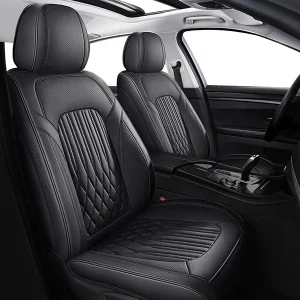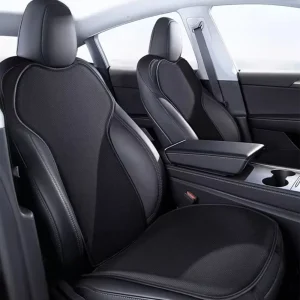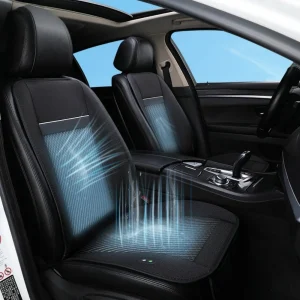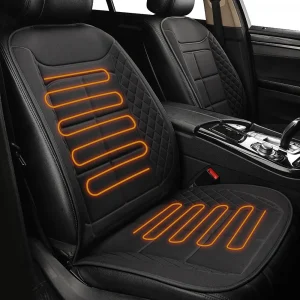Als erfahrener Autobesitzer werde ich oft gefragt, ob es sich lohnt, von Stoffsitze zu Ledersitzen. Die Antwort ist nicht einfach. Es hängt ganz von Ihren persönlichen Vorlieben und Fahrbedürfnissen ab. Hier ist ein detaillierter Vergleich, der Ihnen die Entscheidung erleichtert.
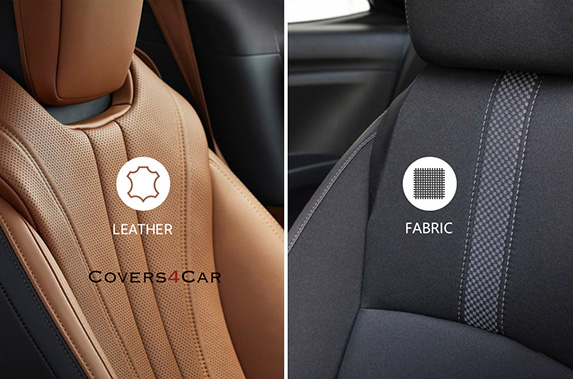
Stoffsitze: Die praktische Option
Stoffsitze gehören in vielen Autos schon lange zum Standard – und das aus gutem Grund: Sie bieten viele Vorteile, vor allem in puncto Komfort und Funktionalität.
Vorteile:
- AtmungsaktivitätStoffsitze sind für ihre Atmungsaktivität bekannt. Im Winter frieren Sie nicht so stark, und auch im Sommer überhitzen Sie nicht. Der Stoff ermöglicht eine bessere Luftzirkulation und sorgt so für mehr Komfort bei extremen Temperaturen.
- HaltbarkeitStoffsitze können zwar mit der Zeit verschleißen, zeigen aber in der Regel nicht so schnell Anzeichen von Beschädigungen wie Ledersitze. Der Stoff ist resistent gegen Risse und Ausbleichen und daher eine praktische Option für den Langzeitgebrauch.
- Erschwinglichkeit: Stoffsitze sind oft preisgünstiger und daher ideal für alle, die bei der Innenausstattung ihres Fahrzeugs Geld sparen möchten.
Nachteile:
- Schwieriger zu reinigenStoffsitze fangen Schmutz, Verschüttetes und Flecken leichter ein als Ledersitze. Sie müssen häufig gereinigt werden und können selbst bei regelmäßiger Pflege abgenutzt aussehen.
- Weniger ästhetischer ReizStoffsitze können zwar bequem sein, bieten aber nicht die elegante, hochwertige Lederoptik. Dies kann für manche ein entscheidender Faktor bei der Wahl der Fahrzeuginnenausstattung sein.
- Weich und weniger stützendStoffsitze sind im Allgemeinen weicher, bieten aber nicht so festen Halt wie Ledersitze. Wenn Sie lange Auto fahren, empfinden Sie Stoffsitze möglicherweise als weniger bequem.

Wenn Sie Wert auf Komfort, Erschwinglichkeit und Zweckmäßigkeit legen, sind Stoffsitze möglicherweise die beste Wahl.
Ledersitze: Das luxuriöse Upgrade
Ledersitze hingegen gelten oft als Luxusmerkmal. Die hochwertige Optik und Haptik von Leder wertet den Innenraum jedes Fahrzeugs auf. Aber sind sie die richtige Wahl für Sie? Werfen wir einen Blick auf die Vor- und Nachteile.

Vorteile:
- Leicht zu reinigenLeder lässt sich mühelos abwischen und reinigen und ist daher eine hervorragende Option für alle, die häufig mit verschütteten Flüssigkeiten oder Haustieren zu tun haben. Die Oberfläche nimmt im Gegensatz zu Stoff weder Schmutz noch Flüssigkeiten auf, sodass Ihre Sitze stets wie neu aussehen.
- Anspruchsvolle Optik: Leder verleiht jedem Auto einen Hauch von Luxus. Seine glatte, glänzende Oberfläche und sein elegantes Aussehen steigern den wahrgenommenen Wert Ihres Fahrzeugs.
- Besserer Support: Ledersitze sind in der Regel fester als Stoffsitze und bieten besseren Halt auf langen Fahrten. Das macht sie ideal, wenn Sie viel Zeit hinter dem Steuer verbringen.
- Haltbarkeit: Leder ist strapazierfähig und hält bei richtiger Pflege deutlich länger als Stoff. Es ist verschleißfest und bei guter Pflege sind die Alterungserscheinungen geringer.
Nachteile:
- Temperatursensitivität: Leder kann im Winter kalt und im Sommer heiß werden, sodass es ohne Sitzheizung oder -kühlung unbequem wird.
- Hoher Wartungsaufwand: Leder muss regelmäßig gereinigt und gepflegt werden, um seine Weichheit und seinen Glanz zu erhalten. Ohne die richtige Pflege kann es mit der Zeit reißen oder verblassen, insbesondere bei Hitze und Sonnenlicht.
- Anfällig für Kratzer und Beschädigungen: Leder ist anfälliger für Kratzer, Einstiche und andere Schäden. Es kann durch scharfe Gegenstände beschädigt werden und bei unsachgemäßer Behandlung reißen oder austrocknen.
Wenn Sie Wert auf ein luxuriöses, hochwertiges Aussehen legen und bereit sind, Zeit in die Pflege Ihrer Sitze zu investieren, könnte Leder die richtige Wahl sein.
Echtes Leder vs. Kunstleder
Bei Ledersitzen gibt es zwei Hauptoptionen: Echtleder und Synthetikleder.
Echtes Leder:
Echtes Leder wird aus natürlicher Tierhaut hergestellt, ist weich, atmungsaktiv und fühlt sich luxuriös an. Es ist eine erstklassige Option für den Fahrzeuginnenraum. Es ist jedoch oft teuer und erfordert mehr Pflege, um Risse und Ausbleichen mit der Zeit zu vermeiden.
Vorteile:
- Weich und bequem: Echtes Leder fühlt sich glatt und seidig an und bietet ein erstklassiges Sitzerlebnis.
- Dauerhaft: Bei richtiger Pflege kann echtes Leder ein Leben lang halten und ist somit eine langfristige Investition.
- Atmungsaktiv: Die Poren von echtem Leder ermöglichen eine bessere Luftzirkulation und halten Sie im Sommer kühl und im Winter warm.
Nachteile:
- Teuer: Echtes Leder ist deutlich teurer als Kunstleder.
- Anfällig für Schäden: Bei zu viel Sonne oder Hitze kann echtes Leder mit der Zeit reißen, austrocknen und verblassen.
Kunstleder (Veganes Leder):
Kunstleder oder Kunst- oder veganes Leder ist ein künstliches Material, das wie echtes Leder aussieht, aber normalerweise günstiger und pflegeleichter ist.
Vorteile:
- Erschwinglich: Kunstleder ist viel günstiger als echtes Leder und daher eine attraktive Option für preisbewusste Käufer.
- Einfach zu pflegen: Kunstleder ist flecken- und spritzwasserbeständig und leicht zu reinigen.
- Keine tierischen Produkte: Kunstleder ist ideal, wenn Sie nach einer tierversuchsfreien Option suchen.
Nachteile:
- Weniger atmungsaktiv: Kunstleder bietet nicht die gleiche Atmungsaktivität wie echtes Leder, was bei extremen Temperaturen unangenehm sein kann.
- Kürzere Lebensdauer: Kunstleder ist zwar strapazierfähig, jedoch weniger langlebig als echtes Leder und kann schneller Abnutzungserscheinungen aufweisen.
Nappaleder: Die Premium-Option
Wenn Sie das Beste aus beiden Welten suchen – das luxuriöse Gefühl von echtem Leder kombiniert mit Haltbarkeit und Weichheit – Nappaleder ist die erste Wahl.
Nappaleder ist eine Art Echtes Leder Bekannt für seine Weichheit, glatte Textur und Strapazierfähigkeit. Im Gegensatz zu anderen Lederarten wird Nappaleder behandelt, um seine natürliche Haptik zu erhalten und gleichzeitig flexibler und widerstandsfähiger gegen Abnutzung zu sein. Seine luxuriöse Optik und Haptik machen es zu einem beliebten Material für hochwertige Fahrzeuge und Premium-Innenräume. Die glatte Oberfläche und der dezente Glanz von Nappaleder sorgen für einen hochwertigen Look, der zeitlos und elegant zugleich ist.
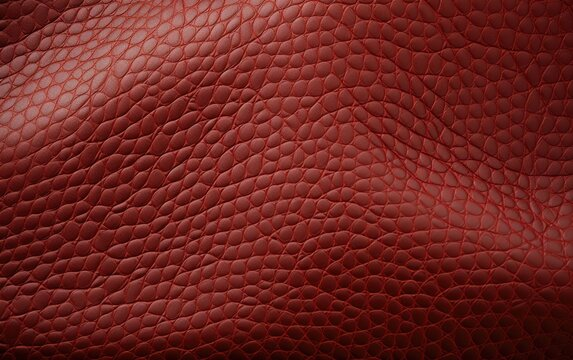
Vorteile:
- Weiches und luxuriöses Gefühl: Nappaleder ist unglaublich weich und bietet ein erstklassiges Gefühl, das Ihr Fahrerlebnis verbessert.
- Haltbarkeit und Langlebigkeit: Nappaleder ist für seine Strapazierfähigkeit und Verschleißfestigkeit bekannt und stellt daher eine hervorragende Investition für den langfristigen Gebrauch dar.
- Atmungsaktivität: Im Gegensatz zu einigen anderen Lederarten ist Nappaleder gut atmungsaktiv und sorgt so in unterschiedlichen Klimazonen für Komfort.
Nachteile:
- Teuer: Wie andere hochwertige Leder kann Nappaleder teuer sein, was es eher zu einer Premium-Option macht.
- Braucht Pflege: Nappaleder benötigt regelmäßige Pflege, um sein optimales Aussehen zu erhalten. Bei unsachgemäßer Pflege kann es mit der Zeit reißen oder verblassen.
Für alle, die das Höchstmaß an Luxus und Komfort suchen, ist Nappaleder die klare Wahl.
Abschließende Gedanken: Was sollten Sie wählen?
Wenn Ihr Auto derzeit Stoffsitze hat und Sie überlegen, ob Sie auf Leder umsteigen sollen, berücksichtigen Sie Ihren Lebensstil und Ihre Vorlieben. Wenn Sie Wert auf Luxus, Langlebigkeit und einfache Pflege legen, ist Leder eine gute Wahl. Wenn jedoch Komfort, Erschwinglichkeitund ein geringer Wartungsaufwand wichtiger sind, ist Stoff möglicherweise die bessere Option.
Für diejenigen, die das Gefühl von Leder erleben möchten, ohne die Bank zu sprengen, Sitzbezüge aus Nappaleder aus Autoabdeckungen könnte die perfekte Lösung sein. Sie bieten das luxuriöse Gefühl von Leder Gleichzeitig sind sie günstiger und einfacher zu warten.
Egal für welche Wahl Sie sich entscheiden, denken Sie daran, dass die Modernisierung Ihrer Sitze Ihren persönlichen Stil und Ihre Fahrgewohnheiten widerspiegeln sollte. Ob die angenehme Atmungsaktivität von Stoff oder die elegante Raffinesse von Leder – achten Sie darauf, dass Ihre Wahl Ihr Fahrerlebnis verbessert.

